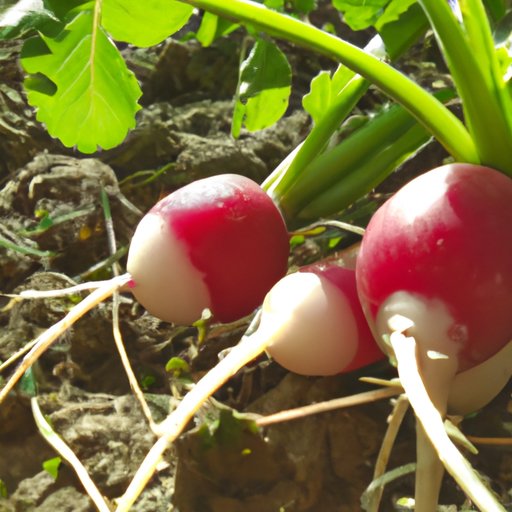Introduction
Radishes are crunchy, juicy root vegetables that come in many shapes, sizes, and colors. They have a slightly spicy flavor and are an excellent source of vitamins and minerals. Eating radishes can be beneficial for your health as they are low in calories and contain a variety of essential nutrients. In this guide, you will learn all about radishes, including how to prepare them, the health benefits of eating them, and tips for growing your own radish garden.
A Guide to Preparing Radishes for Delicious and Nutritious Meals
Before cooking or eating radishes, you need to prepare them properly. Here is a step-by-step guide to properly washing, trimming, and cooking radishes:
Washing Radishes
The first step is to wash the radishes thoroughly. Fill a bowl with cold water and add 2 tablespoons of white vinegar. Soak the radishes in this mixture for 10 minutes, then rinse with cold water. This helps remove any dirt, bacteria, or pesticides that may be on the surface of the radishes.
Trimming Radishes
Next, you will want to trim the ends off the radishes. Cut off the stem end, followed by the root end. You can also peel the skin if desired. If you plan on eating the radishes raw, you may want to cut them into thin slices or cubes.
Cooking Radishes
Radishes can be cooked in a variety of ways. They can be boiled, roasted, sautéed, or added to soups and stir-fries. Boiling is the quickest way to cook radishes, but roasting brings out their sweetness and adds a nice crunch. When roasting, toss the radishes with a bit of oil, salt, and pepper before placing them in the oven at 400°F for about 20 minutes.

The Health Benefits of Adding Radishes to Your Diet
In addition to being tasty and versatile, radishes are also very good for you. They are low in calories and contain a variety of essential vitamins and minerals. According to a study published in the Journal of Food Composition and Analysis, radishes are a great source of vitamin C, potassium, calcium, and magnesium. They also contain antioxidants, which help protect cells from damage caused by free radicals.
Eating radishes has been linked to a number of potential health benefits. Research suggests that they may help reduce inflammation, improve digestion, lower blood pressure, and even boost immunity. However, more research is needed to confirm these potential benefits.

Creative Recipes Using Radishes as the Star Ingredient
Radishes are not just a side dish; they can be used in a variety of creative recipes. Here are some ideas for incorporating radishes into your meals:
Salads
Radishes make a great addition to salads. Try adding thinly sliced radishes to a green salad or making a radish and cucumber salad with a light vinaigrette dressing. For a heartier salad, try combining chopped radishes with quinoa, feta cheese, and parsley.
Soups
Radishes can also be used to make flavorful soups. Try blending cooked radishes with potatoes and carrots for a creamy vegetable soup. Or, add diced radishes to a chicken noodle soup for a burst of flavor.
Stir-Fries
Radishes can be added to any stir-fry. Slice them up and add them to your favorite stir-fry recipe along with other vegetables and proteins. The radishes will add a nice crunch and a hint of spiciness to the dish.
Sautés
Radishes can also be sautéed with garlic and herbs for a simple and flavorful side dish. Sautéed radishes are especially delicious when paired with fish or poultry.
Exploring Different Varieties of Radishes
There are many different varieties of radishes available. The most common type is the red globe radish, which is round and has a crisp texture and mild flavor. Other popular varieties include black Spanish radishes, which are larger and have a more intense flavor, and French breakfast radishes, which are elongated and slightly sweet. There are also specialty radishes such as watermelon radishes, daikon radishes, and purple radishes.
When choosing radishes, it’s important to look for ones that are firm and free from bruises or blemishes. Organic varieties are often the best choice, as they are grown without the use of chemical fertilizers or pesticides.

Tips for Growing Your Own Radish Garden
Growing your own radishes is a fun and rewarding experience. It’s also a great way to get fresh, organic radishes year-round. Here are some tips for starting your own radish garden:
Choosing a Location
When selecting a location for your radish garden, choose a spot that gets at least six hours of direct sunlight each day. Make sure the soil is well-draining and free of weeds. Raised beds are ideal, as they provide better drainage and aeration.
Planting Radishes
Radishes are easy to grow and can be planted directly into the ground or in containers. Plant the seeds ½ inch deep and 1 inch apart. Water the plants regularly and keep the soil moist. Radishes should be ready to harvest in about four weeks.
Harvesting Radishes
When harvesting radishes, gently pull them from the ground. If the radishes are too large, it’s best to leave them in the ground so they don’t become woody. After harvesting, store the radishes in the refrigerator for up to two weeks.
Conclusion
Radishes are a tasty and nutritious vegetable that can be enjoyed in a variety of ways. From salads to stir-fries, there are countless creative recipes featuring radishes as the star ingredient. Radishes are also easy to grow, making them a great addition to any home garden. With the right preparation and a few simple ingredients, you can enjoy the many benefits of eating radishes.
(Note: Is this article not meeting your expectations? Do you have knowledge or insights to share? Unlock new opportunities and expand your reach by joining our authors team. Click Registration to join us and share your expertise with our readers.)
